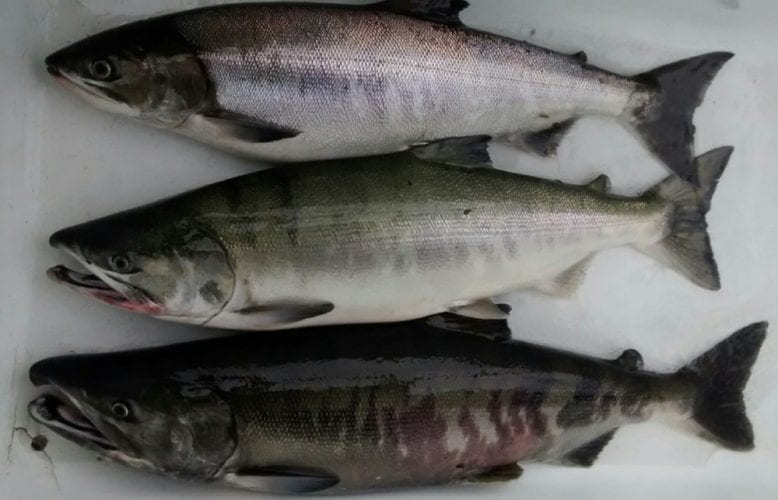A new run of hatchery chum salmon south of Sitka looks like it will wind up about five times what was forecast to return. And a larger run could be returning next year.
Audio PlayerThere are still more purse seine openings planned this month at Crawfish Inlet, about 40 miles south of Sitka. The run is in its second year of adult returns. And it’s produced by the Sitka-based private non-profit Northern Southeast Regional Aquaculture Association, or NSRAA. The hatchery organization estimates seiners caught at least 100,000 pounds during an opening September 20th. Earlier in the month a one-day opening set a record with over 900,000 chums landed by the fleet.
NSRAA general manager Steve Reifenstuhl expects the run will finish up around 3.4 million fish. The forecast was 680-thousand chum.
“You know I’m thrilled that this came in a year that seiners and trollers really needed a break and I’m glad to be part of NSRAA that it created that opportunity for ‘em,” Reifenstuhl said.
The fall-run hatchery enhanced fish provided late season fishing for the troll fleet in a year with big reductions in king salmon opportunity and a boost for seiners who stayed out fishing into September after the lowest pink salmon catch in over four decades.
Reifenstuhl thinks a couple of factors probably factored into the unexpected big return. He thinks young salmon, or fry, were not intercepted by whales and other predators that maybe impacting other hatchery returns.
“Obviously to have good survival the fry have to escape the near-shore area where there is normally tremendous mortality,” Reifenstuhl said. “And secondly there’s gotta be food in the ocean for them when they spend the next 2 and 3 years out in the North Pacific. So my guess is both those environments were in their favor for these fish that came back this year.”
Chum returns are made up of fish that have been alive three, four or five years. The older fish spend more time in the ocean before returning. The big return at Crawfish was driven by nearly 10 percent marine survival for three-year-old fish. What’s typical is less than one percent. And normally these younger fish only make up a small portion of the run. That wasn’t the case for this return.
“The number of four-year-olds was roughly at this point 550,000 four-year-olds and 2.7 million three-year-olds,” Reifenstuhl said. “I mean I don’t think there’s any chum program anywhere that’s seen anything like it. The closest I’m aware of is at Deep Inlet, where we have seen 1.4 million three-year-olds one year and then the following year the run was three and a half million or so.” Deep Inlet is the site of another NSRAA hatchery chum return.
What’s on the horizon for next year at Crawfish is a bit of a mystery for hatchery managers. More of those fish that are three-year-olds this year could be staying out in the ocean another winter and returning next year as four-year-olds. But how many is the big question. Reifenstuhl looks at the survival rate for fish in the first year of releases. Those came back as three-year-olds last year and four-year-olds this year. He said there were nearly three four-year-olds this year for every one three-year-old last year.
“So if you just look at that ratio and expect that might happen next year, even that doesn’t seem to make sense,” he said. “I mean I suppose anything can happen. But if you use that ratio of 2.9 to 1 that would mean next year’s forecast would be something on the order of 8 million fish. We just don’t think that can happen. So we’re probably going to downgrade it, not use our typical regression, and even what we’ve seen in one past year and we’re probably going to have a forecast of something like four million chum salmon for 2019.”
Because of the big run this year, NSRAA says it doesn’t need to cost recovery fishing at Crawfish next year, to fund hatchery operations. That means another bumper crop of chums would be available solely for fishing fleets.
Another new NSRAA site at Thomas Bay near Petersburg will be seeing its first three-year-old chum returns next summer. But Reifenstuhl cautions he doesn’t expect the same unusual ocean survival there.












